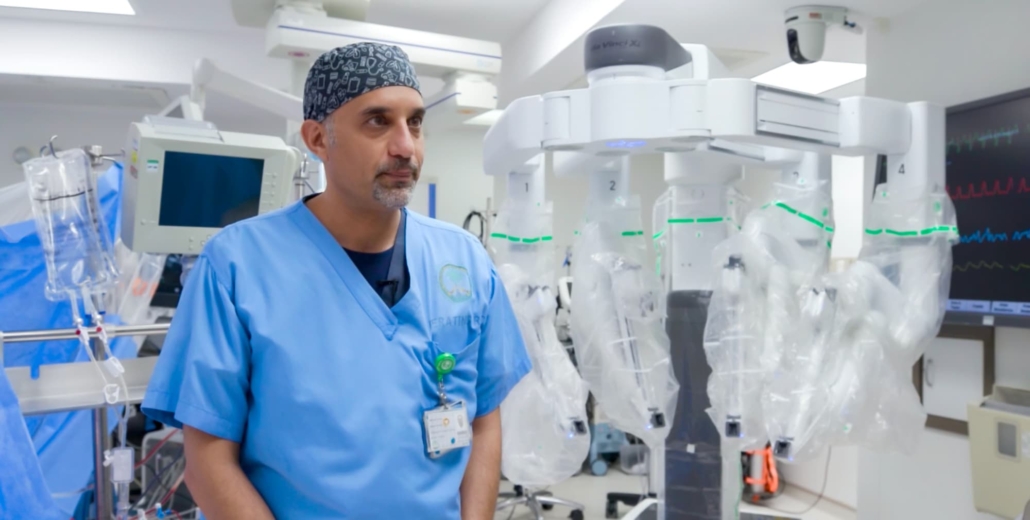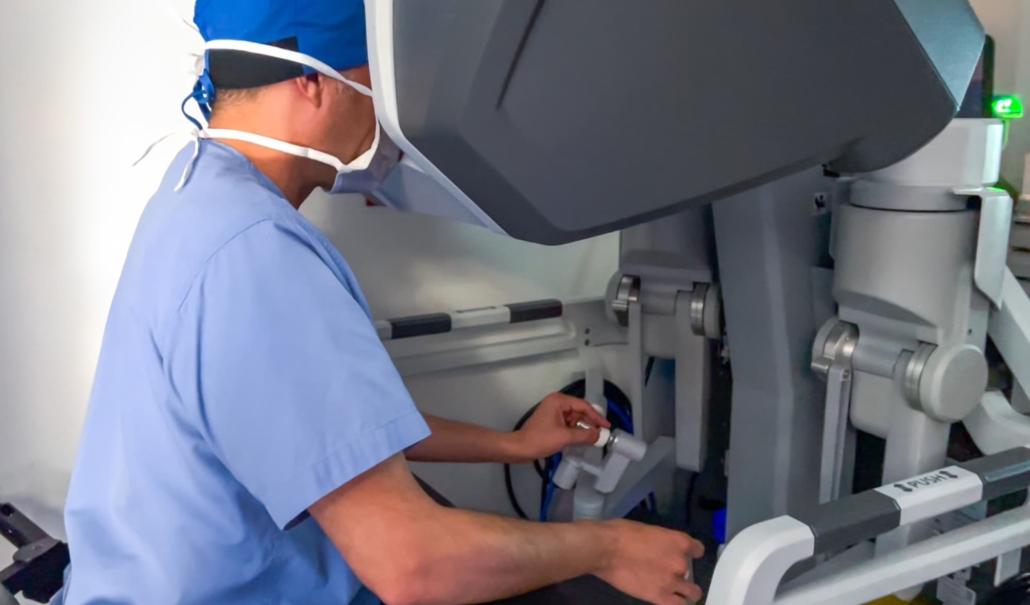The world’s first fully robotic heart transplant: We interview the cardiac surgeon about the procedure
In an historic achievement, Dr. Feras Khaliel and his team at King Faisal Specialist Hospital & Research Centre (KFSHRC) in Riyadh, Saudi Arabia, successfully performed the world’s first fully robotic heart transplant on a 16-year-old patient with end-stage heart failure. This innovative procedure reduced recovery times and surgical risks, setting a new standard for cardiac surgery worldwide. In this interview with International Hospital, Dr. Khaliel shares insights into the challenges, advances, and future potential of robotic heart transplants.

Dr. Feras Khaleil, Head of Cardiac Surgery and Director of the Robotics and Minimally Invasive Surgery Program at King Faisal Specialist Hospital & Research Centre.
International Hospital: What motivated you to attempt a heart transplant using a robot, and how long did the preparation for this groundbreaking procedure take? How long did the procedure take?
Dr. Feras Khaliel: The motivation behind attempting a robotic heart transplant stemmed from a desire to push the boundaries of what’s possible in cardiac surgery and leverage emerging technologies to enhance patient outcomes. The preparation for this procedure was thorough and methodical, spanning several weeks of detailed planning. We began by laying the theoretical groundwork, mapping out every step to minimize risks and ensure the highest level of accuracy during surgery.
Once the approach was finalized, the team conducted virtual rehearsals, practicing the entire procedure seven times over the course of three days. These simulations were crucial in refining the process, ensuring every team member fully synchronized with the technology and their specific roles. We developed a minimally invasive approach that allowed us to access the heart without a traditional chest-opening procedure, which was essential in reducing recovery time and minimizing complications.
The surgery itself took two and a half hours, a significant reduction from the usual 6 to 12 hours required for traditional heart transplants. This efficiency, combined with cutting-edge robotic technology, resulted in an improved patient recovery experience.
IH: What robot did you use, and can you describe some of the key technological advancements in robotic surgery that made this procedure possible?
Dr. Feras Khaliel: The robot features 3D visualization technology, allowing the surgical team to view the heart in high definition from multiple angles. This gives us an enhanced view of the heart, far superior to traditional methods. The robotic arms are equipped with miniaturized instruments, enabling extremely fine movements that would be difficult to replicate by hand.
Another key advancement was the haptic feedback system, which enabled us to assess tissue consistency without direct contact, reducing the risk of injury. These innovations were critical in making this procedure successful, combining technology with human expertise for optimal outcomes.
IH: What parts of the procedure were performed by the robot? In other words, were some parts of the procedure still performed by hand?
Dr. Feras Khaliel: The robot handled the most delicate aspects of the surgery, such as making precise incisions and performing the transplant itself. However, human intervention was still necessary for certain critical tasks. The surgical team was responsible for crucial aspects like positioning the patient and monitoring their overall condition. This was a collaborative effort where the technology and the team worked seamlessly together to ensure the best results.
IH: How does the robotic approach differ from traditional heart transplant techniques in terms of surgical precision and patient outcomes?
Dr. Feras Khaliel: The robotic approach offers several advantages over traditional methods, particularly regarding the control it provides during surgery. The dexterity of the robotic arms allows for more controlled movements, especially in confined spaces, which reduces the risk of errors and complications. The enhanced visualization enabled us to navigate the heart’s complex structures safely and accurately.
One key benefit is the reduced physical strain on the surgical team, allowing us to maintain a high level of performance during longer procedures. For patients, this approach leads to quicker recovery times, less pain, and fewer complications, making the entire process more efficient and less traumatic.
IH: What were the main challenges you encountered during the procedure, and how did you overcome them?
Dr. Feras Khaliel: The biggest challenge was ensuring perfect synchronization between the robotic system and the surgical team. While not new to KFSHRC, robotic surgery requires detailed coordination, especially in complex procedures like heart transplants. Additionally, the intricacies of heart surgery posed unique challenges, different from other robotic procedures, such as the liver transplant we previously performed.
We overcame these challenges through extensive planning and rehearsals, ensuring everyone was aligned and the technology perfectly harmonious with human expertise. Communication and coordination were vital to ensuring the success of the surgery.
IH: Looking at the post-operative recovery process for the patient – how does it compare to recovery after a conventional heart transplant?
Dr. Feras Khaliel: This pioneering robotic heart transplant represents a significant shift from traditional heart transplant methods. Unlike conventional chest-opening procedures, which often require long recovery periods lasting weeks or even months, robotic technology allows for a minimally invasive approach. In this case, the patient experienced a faster recovery, with reduced pain and fewer post-operative complications. The smaller incisions during the robotic procedure led to quicker healing and less scarring, allowing the patient to resume daily activities sooner. This advanced approach offers a more efficient recovery.
IH: What are the potential advantages of robotic heart transplants in terms of reducing surgical trauma and improving patient recovery times?
Dr. Feras Khaliel: Robotic heart transplants can offer several advantages in reducing surgical trauma. The procedure’s minimally invasive nature leads to less damage to surrounding tissues. This results in reduced post-operative pain, a lower risk of infection, and faster healing times.
Additionally, robotic surgery shortens surgical times, which is an important factor in minimizing risks associated with prolonged procedures. Longer operative times have been linked to higher rates of complications such as surgical site infections, sepsis, and pneumonia. Extended surgeries also increase the duration of anesthesia, contributing to further complications like venous thromboembolism and wound dehiscence. By reducing the time spent in surgery, robotic heart transplants lower the likelihood of these issues, providing patients a smoother and safer recovery process.
IH: How do you envision this technique impacting the field of cardiac surgery and organ transplantation in the coming years?
Dr. Feras Khaliel: I believe robotic heart transplants will become a standard part of cardiac surgery as technology continues to advance. The precision and control offered by robotic systems are particularly valuable for complex procedures like heart transplants, and I expect these techniques to be adopted across a more comprehensive range of surgeries.
KFSHRC has already explored the potential of fully robotic procedures through its successful work with a liver transplant, further proving how versatile this technology can be across different transplant operations. This approach also has the potential to increase the availability of surgeries by reducing operating times and recovery periods, ultimately allowing more patients to access life-saving treatments.
At KFSHRC, our Robotic Cardiac Surgery Program has achieved significant results, performing the highest volume of robotic cardiac surgeries outside the USA and ranking among the top five worldwide. With over 400 robotic cardiac surgeries and a 98% survival rate, we have demonstrated the success of robotic systems in complex procedures such as multi-valve operations and aortic valve replacements. Using advanced robotic technology has reduced pain, shortened hospital stays by over 50%, and lowered costs by 40% compared to conventional methods. As this technology continues to evolve, it has the potential to alleviate pressure on healthcare systems by streamlining surgeries and improving patient outcomes on a larger scale.
IH: Are there any specific types of patients or conditions for which robotic heart transplants might be particularly beneficial or contraindicated?
Dr. Feras Khaliel: Robotic heart transplants can be especially beneficial for patients at higher risk for complications with traditional surgery. However, as with any medical procedure, each case is carefully evaluated to determine the best course of action for the patient.
In some cases, robotic surgery may not be suitable. Patients with complex heart conditions affecting multiple areas of the heart or those with unique anatomical considerations might benefit more from traditional open-heart surgery.
The goal is always to strike the right balance between innovation and effective treatment, ensuring that the approach chosen provides the best possible care while minimizing risks. Robotic surgery is a wonderful option for many patients. Still, for others, a different approach may be necessary to ensure safety and success. The focus remains on selecting the method that offers the greatest benefit to the patient while delivering innovative and effective treatment.
IH: Looking ahead, what further innovations or refinements in robotic cardiac surgery do you anticipate or hope to see shortly?
Dr. Feras Khaliel: Advancements in robotic technology are expected to bring even greater precision, enhanced AI integration, and more advanced visualization tools. These developments could result in even less invasive procedures and more informed decision-making during surgery. As AI becomes more refined, robotic systems may eventually manage more complex tasks autonomously, leading to faster surgeries and more precise surgical outcomes.
At KFSHRC, we continue to expand our efforts in robotic surgery. In 2023, the hospital successfully completed 1,195 robotic-assisted procedures across various specialties. Our integration of AI in patient management and diagnostics has further enhanced precision and efficiency.
These innovations, along with the integration of AI for improved surgical decision-making, have transformed surgery as we know it, empowering surgeons to perform complex tasks more efficiently and increasing access to specialized care. By continuously expanding our robotic programs and leveraging AI to optimize outcomes, KFSHRC is setting new global patient care standards. The future holds exciting possibilities for further advancing patient experiences through robotic-assisted surgery, and I believe we are just scratching the surface of what can be achieved.


